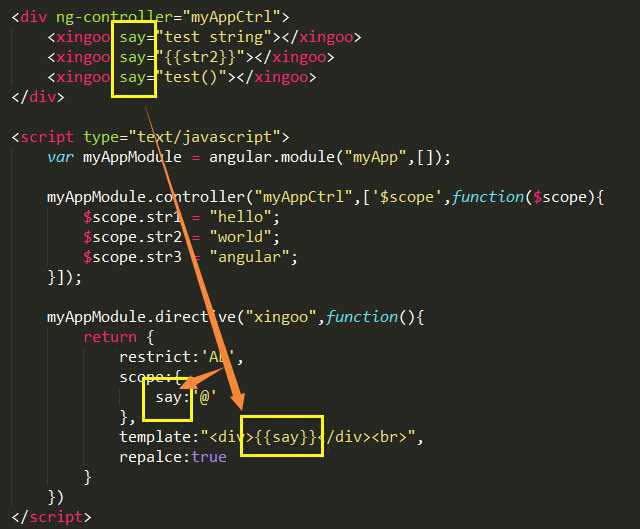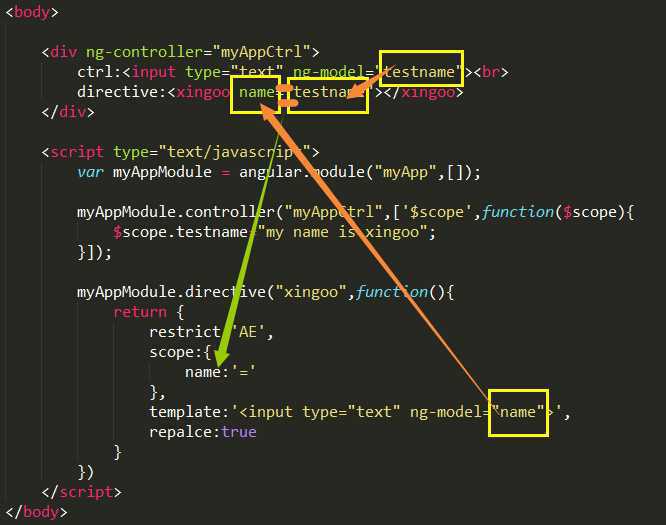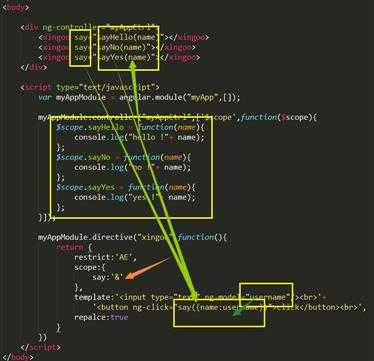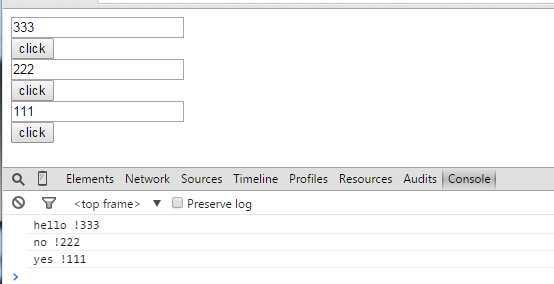标签:
前面通过视频学习了解了指令的概念,这里学习一下指令中的作用域的相关内容。
通过独立作用域的不同绑定,可以实现更具适应性的自定义标签。借由不同的绑定规则绑定属性,从而定义出符合更多应用场景的标签。
本篇将会总结下面的内容:
1 为何需要独立作用域
2 如何实现独立作用域
3 作用域的数据绑定
为了便于理解,先看一下下面这个例子:
<!doctype html> <html ng-app="myApp"> <head> <meta http-equiv="Content-Type" content="text/html; charset=utf-8" /> <script src="http://apps.bdimg.com/libs/angular.js/1.2.16/angular.min.js"></script> </head> <body> <div> <xingoo></xingoo> <xingoo></xingoo> <xingoo></xingoo> </div> <script type="text/javascript"> var myAppModule = angular.module("myApp",[]); myAppModule.directive("xingoo",function(){ return { restrict:‘AE‘, template:‘<div><input type="text" ng-model="username"/>{{username}}</div><br>‘, repalce:true } }) </script> </body> </html>
可以看到,在script中,创建了一个指令,该指令实现了一个自定义的标签。
标签<xingoo></xingoo>的作用是 替换成 一个输入框和一个数据显示。
这样就会出现下面的效果:

分析:
当我们自己创建某个指令时,这个指令肯定不可能只使用一次,是要重复多次使用的,有的在一个页面内或者一个控制器内需要使用多次。
类似上面的这种场景,在任何一个输入框内改变数据,都会导致其他的标签内的数据一同发生改变,这显然不是我们想要的。
这个时候就需要独立作用域了。
下面看看独立作用域的效果:
<script type="text/javascript">
var myAppModule = angular.module("myApp",[]);
myAppModule.directive("xingoo",function(){
return {
restrict:‘AE‘,
scope:{},
template:‘<div><input type="text" ng-model="username"/>{{username}}</div><br>‘,
repalce:true
}
})
</script>
只需要在定义指令时,添加scope:{}这个属性,就可以使标签拥有自己的作用域。
仅仅是添加这一行代码而已,就实现了独立作用域。
在进行输入时,每个模板内使用自己的数据,不会相互干扰。

自定义标签或者进行扩展时,会有这样的需求场景,要在标签中添加一些属性,实现一些复杂功能。
关于这些属性,独立作用域是如何的做的呢?看看下面的内容吧。
举个例子:
<xingoo say="name"></xingoo> <xingoo say="name()"></xingoo>
假设传入的是上面这种,我们如何区分它传入的到底是变量呢?还是字符串呢?还是方法呢?
因此AngularJS有了三种自定义的作用域绑定方式:
1 基于字符串的绑定:使用@操作符,双引号内的内容当做字符串进行绑定。
2 基于变量的绑定:使用=操作符,绑定的内容是个变量。
3 基于方法的绑定:使用&操作符,绑定的内容时个方法。
<!doctype html> <html ng-app="myApp"> <head> <meta http-equiv="Content-Type" content="text/html; charset=utf-8" /> <script src="http://apps.bdimg.com/libs/angular.js/1.2.16/angular.min.js"></script> </head> <body> <div ng-controller="myAppCtrl"> <xingoo say="test string"></xingoo> <xingoo say="{{str2}}"></xingoo> <xingoo say="test()"></xingoo> </div> <script type="text/javascript"> var myAppModule = angular.module("myApp",[]); myAppModule.controller("myAppCtrl",[‘$scope‘,function($scope){ $scope.str1 = "hello"; $scope.str2 = "world"; $scope.str3 = "angular"; }]); myAppModule.directive("xingoo",function(){ return { restrict:‘AE‘, scope:{ say:‘@‘ }, template:"<div>{{say}}</div><br>", repalce:true } }) </script> </body> </html>
看一下代码,在body中使用了三次自定义的标签,每种标签的内部有一个say的属性,这个属性绑定了一个双引号的字符串。
在指令的定义中,添加了scope:{say:‘@‘}这个键值对属性,也就是说,angular会识别say所绑定的东西是一个字符串。
在模板中,使用表达式{{say}}输出say所表示的内容。

可以看到,双引号内的内容都被当做了字符串。当然{{str2}}表达式会被解析成对应的内容,再当做字符串。

<!doctype html> <html ng-app="myApp"> <head> <meta http-equiv="Content-Type" content="text/html; charset=utf-8" /> <script src="http://apps.bdimg.com/libs/angular.js/1.2.16/angular.min.js"></script> </head> <body> <div ng-controller="myAppCtrl"> ctrl:<input type="text" ng-model="testname"><br> directive:<xingoo name="testname"></xingoo> </div> <script type="text/javascript"> var myAppModule = angular.module("myApp",[]); myAppModule.controller("myAppCtrl",[‘$scope‘,function($scope){ $scope.testname="my name is xingoo"; }]); myAppModule.directive("xingoo",function(){ return { restrict:‘AE‘, scope:{ name:‘=‘ }, template:‘<input type="text" ng-model="name">‘, repalce:true } }) </script> </body> </html>
在上面的代码中,可以看到
1 在控制器myAppCtrl对应的div中,定义了一个变量ng-model —— testname。
2 testname对应的是输入框中输入的值。
3 然后把这个变量当做一个参数传递给xingoo这个标签的name属性。
4 在xingoo标签中,又把这个name绑定到模板中的一个输入框内。
最终两个输入框的内容被连接起来,无论改变哪一个输入框内的值,testname与name都会发生改变。

通过下面这张图可以看出来:
在指令中通过scope指定say绑定规则是变量的绑定方式。
最终通过xingoo标签内的属性依赖关系把 testname与name连接在一起:

上面展示了基于字符串和变量的绑定方法,下面看看基于方法的绑定:
<!doctype html> <html ng-app="myApp"> <head> <meta http-equiv="Content-Type" content="text/html; charset=utf-8" /> <script src="http://apps.bdimg.com/libs/angular.js/1.2.16/angular.min.js"></script> </head> <body> <div ng-controller="myAppCtrl"> <xingoo say="sayHello(name)"></xingoo> <xingoo say="sayNo(name)"></xingoo> <xingoo say="sayYes(name)"></xingoo> </div> <script type="text/javascript"> var myAppModule = angular.module("myApp",[]); myAppModule.controller("myAppCtrl",[‘$scope‘,function($scope){ $scope.sayHello = function(name){ console.log("hello !"+ name); }; $scope.sayNo = function(name){ console.log("no !"+ name); }; $scope.sayYes = function(name){ console.log("yes !"+ name); }; }]); myAppModule.directive("xingoo",function(){ return { restrict:‘AE‘, scope:{ say:‘&‘ }, template:‘<input type="text" ng-model="username"/><br>‘+ ‘<button ng-click="say({name:username})">click</button><br>‘, repalce:true } }) </script> </body> </html>
这段代码中scope中的绑定规则变成了&,也就是方法绑定。
在body中,通过自定义标签传入了三个方法,分别是sayHello(name),sayNo(name),sayYes(name),这三个方法都需要一个name变量。
在指令的定义中,模板替换成一个输入框,一个按钮:
输入框:用于输入username,也就是三个方法需要的参数name。
按钮:点击触发函数——通过绑定规则,绑定到相应的方法。

也就是说
通过say在scope中的定义,angular知道了say对应的是个方法;
通过{name:username}的关联,知道了传入的是username。
从而交给对应的方法执行。
页面效果:

[1] 大漠穷求,AngularJS实战:http://www.imooc.com/video/3085/0
标签:
原文地址:http://www.cnblogs.com/xing901022/p/4291521.html